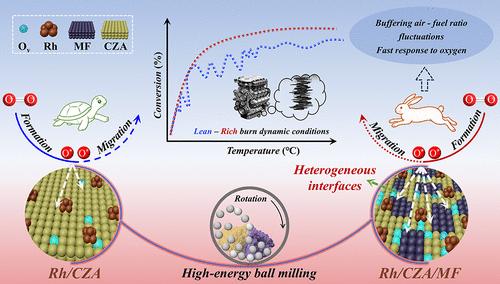机械化学方法诱导构建Mn-Ov-Ce桥接结构促进氧动态迁移和缓冲空燃比波动
IF 11.3
1区 环境科学与生态学
Q1 ENGINEERING, ENVIRONMENTAL
引用次数: 0
摘要
频繁启停的城市驾驶环境对三元催化剂(twc)的动态响应能力提出了挑战,而对氧气的快速响应对于缓冲空燃比波动至关重要。在此,我们合成了具有优异储氧能力的非化学量Mn1.5Fe1.5O4 (MF)尖晶石,并通过高能球磨将其引入Rh/CeO2-ZrO2-Al2O3 (Rh/CZA)中,形成复合结构TWCs。在富贫燃烧振荡条件下(λ = 0.98-1.02,开关频率为1 Hz),催化剂表现出较宽的工作窗口和相似的稳态催化效果。MF的加入不仅保留了其良好的储氧能力,而且在MF- cz异相界面上产生了丰富的氧空位,从而协同促进活性氧的快速形成和迁移。此外,Mn-Ov-Ce桥接结构较低的氧空位形成能(Eform)促进了界面氧空位的快速形成和活性氧的快速解吸,这对提高反应速率和缓冲空燃比波动具有重要意义。本研究提出了一种增强TWCs动态响应性的策略,并对异质界面上活性氧的形成机制和迁移过程提供了重要的见解。本文章由计算机程序翻译,如有差异,请以英文原文为准。

Mechanochemical Method-Induced Construction of the Mn–Ov–Ce Bridged Structure to Promote Oxygen Dynamic Migration and Buffer Air–Fuel Ratio Fluctuations
Urban driving conditions characterized by frequent start-and-stop operations challenge the dynamic responsiveness of three-way catalysts (TWCs), and the rapid response to oxygen is crucial to buffering air–fuel ratio fluctuations. Herein, we synthesized nonstoichiometric Mn1.5Fe1.5O4 (MF) spinel with excellent oxygen storage capacity and introduced it into Rh/CeO2-ZrO2-Al2O3 (Rh/CZA) via high-energy ball milling to form the composite structure TWCs. The catalysts significantly show a wide operating window and similar steady-state catalytic effects under lean–rich burn oscillating conditions (λ = 0.98–1.02; switching frequency, 1 Hz). MF incorporation not only retains its excellent oxygen storage capacity but also results in the generation of abundant oxygen vacancies on MF-CZ heterogeneous interfaces, thus synergistically promoting the rapid formation and migration of active oxygen species. Furthermore, the lower oxygen vacancy formation energy (Eform) for the Mn–Ov–Ce bridged structure promotes the rapid formation of interfacial oxygen vacancies and the facile desorption of active oxygen species, which is important to enhance the reaction rates and buffer air–fuel ratio fluctuations. This study presents a strategy to enhance the dynamic responsiveness of TWCs and offers critical insights into the formation mechanisms and migration of the active oxygen species process on heterogeneous interfaces.
求助全文
通过发布文献求助,成功后即可免费获取论文全文。
去求助
来源期刊

环境科学与技术
环境科学-工程:环境
CiteScore
17.50
自引率
9.60%
发文量
12359
审稿时长
2.8 months
期刊介绍:
Environmental Science & Technology (ES&T) is a co-sponsored academic and technical magazine by the Hubei Provincial Environmental Protection Bureau and the Hubei Provincial Academy of Environmental Sciences.
Environmental Science & Technology (ES&T) holds the status of Chinese core journals, scientific papers source journals of China, Chinese Science Citation Database source journals, and Chinese Academic Journal Comprehensive Evaluation Database source journals. This publication focuses on the academic field of environmental protection, featuring articles related to environmental protection and technical advancements.
 求助内容:
求助内容: 应助结果提醒方式:
应助结果提醒方式:


